Start your day right
Sign up for Essential California for news, features and recommendations from the L.A. Times and beyond in your inbox six days a week.
You may occasionally receive promotional content from the Los Angeles Times.

Proposition 35 would permanently impose a tax on health insurance providers like Anthem Blue Cross and L.A. Care, known as managed care organizations, that provide or arrange services for a monthly payment. The ballot measure would also designate how the money can be used.
The proposal comes as California lawmakers have expanded the pool of people eligible for Medi-Cal, the California Medicaid program, to include people who meet income criteria regardless of their immigration status. Healthcare providers and advocacy groups have complained, however, that California does not pay adequately for providing care under Medi-Cal. Proposition 35 aims to boost that funding.
This isn’t a new thing: California has imposed an “MCO tax” off and on over the years. In summer 2023, Gov. Gavin Newsom and state lawmakers decided to renew the tax to help fund Medi-Cal as the state made more Californians eligible for coverage. The tax is expected to generate between $6 billion and $9 billion annually through 2026, the Legislative Analyst’s Office estimated last year.
Lawmakers said they would dedicate some of that tax revenue to increase the reimbursement rates that healthcare providers are paid under Medi-Cal. Healthcare providers said boosting rates was crucial to prevent Medi-Cal patients from facing shortages of providers and long waits.
This year, however, Newsom sought to repurpose billions of dollars from the MCO tax to cover other Medi-Cal program costs. The budget plan ultimately agreed to by state lawmakers included money for Medi-Cal rate increases for healthcare providers, but less than what was previously planned.
Proposition 35 would spell out how the MCO tax revenue can be used. It would also limit the ability of California lawmakers to reroute such funding for other uses, requiring at least three-quarters of members from each house — the state Assembly and Senate — to amend the measure in the future.
It would also set up a new committee that would advise the Department of Health Care Services on efforts supported by the tax money, which would include people representing physicians, hospitals, clinics, organized labor and other groups involved in healthcare.
In the short term, the ballot measure would require the money to be allocated in generally the same way that California had been planning before Newsom sought to repurpose the funds.
That would include increases in the reimbursement rates paid to healthcare providers under the Medi-Cal program and funding to help train healthcare workers, among other efforts. Some money would go to help cover costs for Medi-Cal in the general fund, the state account that pays for most public services.
Starting in 2027, the ballot measure sets out a formula for funding different programs, with some spending hinging on how much money the tax pulls into state coffers.
Proposition 35 is backed by the Coalition to Protect Access to Care, which includes a range of groups involved in healthcare. Among them are the California Hospital Assn., the California Medical Assn., Planned Parenthood Affiliates of California, labor unions, emergency responders and community health centers. Both the California Democratic Party and the California Republican Party support it.
The ballot measure is an opportunity to “invest in providers in a way that would allow folks to expand the patient population” they serve, and for providers already assisting Medi-Cal patients to “expand the services they provide,” said Jodi Hicks, president and chief executive of Planned Parenthood Affiliates of California.
It’s important that “the system as a whole is funded so that patients can get the care they need,” Hicks said. For instance, she said, if a Medi-Cal patient can get a mammogram at a clinic, specialty care also needs to be available if that mammogram shows something is wrong.
California has made strides in expanding who is eligible for Medi-Cal and what services are covered, “but we need to guarantee for folks that if they are on the program, they are able to access those services.”
The Legislative Analyst’s Office said in an analysis last year that the ballot measure could give state lawmakers less flexibility to balance the California budget in the future. Newsom wanted the coalition backing the measure to take it off the ballot, The Times has reported.
The state has also passed a budget that relies on the money from the MCO tax. Passing Proposition 35 could unravel some of those existing plans for the funding, according to provisions in the health budget bill.
Hicks said that Proposition 35 guarantees that some of the tax money would go into the general fund, where state leaders “would have that flexibility to spend those dollars in health care.” She added that the measure does not bar lawmakers from approving funding for other programs that they want to support.
Gov. Gavin Newsom and Democratic lawmakers work to settle their differences over a few key budget cuts to reduce California’s massive deficit.
Start your day right
Sign up for Essential California for news, features and recommendations from the L.A. Times and beyond in your inbox six days a week.
You may occasionally receive promotional content from the Los Angeles Times.